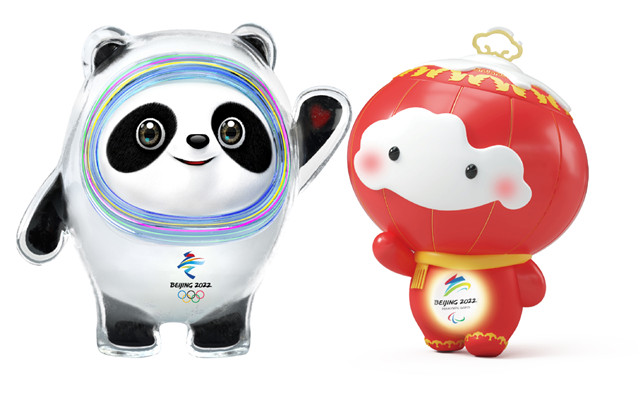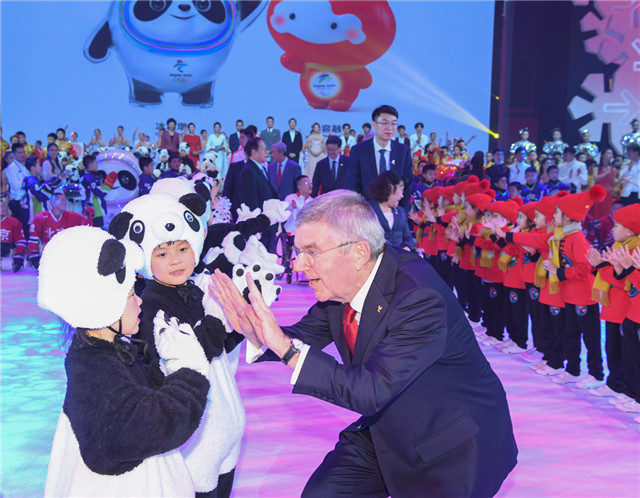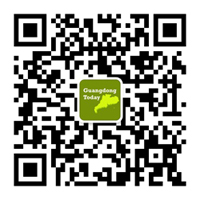A behind-the-scenes look at how a panda and a red lantern won the hearts of 2022 Games organizers

A cute panda "from the future" and a traditional red lantern signifying China's past were unveiled as the respective mascots for the Beijing Olympics and Paralympics on Tuesday, ratcheting up anticipation for the 2022 Winter Games.
Just over a year since submissions were first invited for the project, panda Bing Dwen Dwen and red lantern Shuey Rhon Rhon were revealed as the winners at Beijing's Shougang Ice Hockey Arena.
The 2022 organizing committee is confident the pair will resonate with the world.
"Today is an important step on Beijing's historic journey as the first city in Olympic history to host both summer and winter editions of the Games," said International Olympic Committee (IOC) president Thomas Bach.
"The mascot will be a wonderful ambassador for both China and the 2022 Beijing Winter Olympic Games."
International Paralympic Committee (IPC) president Andrew Parsons said the mascot "is a message of the future to the future generation of Chinese people who will be inspired by the amazing faith of the Paralympic athletes".
Added Gao Tian, vice-director of the culture and ceremonies department of the organizing committee: "The two mascots are a combination of inheritance and innovation, culture and technology, as well as the Olympic Games and daily life."
Back to the future
Bing Dwen Dwen is described as a panda wearing an icy shell that is stylized as a sports helmet. The outfit is similar to a spacesuit, so the panda can be imagined as a winter sports athlete from the future. The ice shell also allows for the addition of new elements.
Many details of the design reference signature elements of the 2022 Games.
A series of colored floating lines around its head resemble tracks on an ice rink, similar to Games venue the National Speed Skating Oval, aka the "Ice Ribbon". The rings are also a nod to the implementation of ultra-fast 5G technology and are meant to empower the panda.
Bing means "ice" in Chinese, which is a symbol of purity and toughness, in line with the spirit of the Olympics. Dwen suggests health and ingenuity, with the repetition of the word giving it a more informal, friendly feel. Altogether, Bing Dwen Dwen is a representation of physical strength, mental toughness and the spirit of the Olympics.
Paralympic mascot Shuey Rhon Rhon is equally intricate in its meaning. It resembles an iconic Chinese red lantern commonly seen on doors and streets during Chinese New Year, which in 2022 falls three days before the Olympic Games opening ceremony. Red lanterns symbolize happiness, harvest and affluence, while the crown-like ruyi is a symbol of sovereignty in Chinese culture.
Shuey Rhon Rhon's head is adorned with paper cuttings of pigeons, a common motif in Chinese culture. Their arrangement forms the shape of the Temple of Heaven, one of Beijing's most famous landmarks. The blush on the mascot's cheeks adds a festive feel, with the color red associated with good luck.
Billed as the first-ever luminous Olympic mascot, Shuey Rhon Rhon is intended to convey a message of lighting up people's dreams and symbolizes friendship, courage and persistence. It is also a representation of the unbending will and fighting spirit of the Paralympic athletes.
Shuey means "snow" in Chinese, while Rhon Rhon are two different Chinese characters with the same pronunciation, meaning inclusiveness and integration respectively. The name symbolizes harmony and exchanges between different cultures, and building a community with a shared future.
"The mascots draw inspiration from China's rich culture, at the same time reflecting the Chinese philosophy of communicating with the world and reaching out to the future," explained review panel member Zhang Yiwu, a professor at the Department of Chinese Language and Literature of Peking University.
Tough decision
The 2022 organizing committee launched a global appeal for mascot design proposals on Aug 8 last year, coinciding with the 10th anniversary of the 2008 Beijing Summer Olympics.
Elementary and high school students across China were encouraged to create their own mascots for the Winter Games. Nearly 15 million students from 45,000 schools were involved, with their designs used as barometers of what appeals to kids.
"When we visited schools in northern China, we could tell they were familiar with winter sports and had a great passion for them. When we visited southern cities, students came with curiosity and listened attentively. The contrast left a deep impression on me, but all of them were happily involved in the designs," recalled Piao Xuedong, the organizing committee's marketing director.
When the two-month submission period closed on Oct 31, a total of 5,816 designs were spread over 100 desks in a room inside the Beijing 2022 headquarters at Shougang Industrial Park.
Submissions were received from all over the world-35 countries and regions in total-while the designers ranged in age from 3 to 75. Among the more commonly used ideas were indigenous deers, pandas and tigers, and cultural symbols such as dragon dancing and the Great Wall.
According to the organizing committee, the number of design proposals was nearly three times that of the 2008 Games.
"There was a lot of diversity, with everyone from little children to professionals submitting proposals. It's interesting to see the different directions people have taken," said panel member Alexis Georgacopoulos, director of the University of Art and Design in Lausanne, Switzerland, where the IOC is based.
The 18-person review panel was comprised of experts from fields including graphic design, animation, children's literature and marketing, and after two days of evaluation whittled the submissions down to 100 possibles on Jan 7. The next day, the panel compiled a shortlist of 10 designs.
The panel was guided by an online survey that sought to discover the public's preference for features such as color and personality of the mascots.
"A great number of the designs were quite creative, and that really amazed me," said panel member Lin Cunzhen, who designed the emblems for Beijing 2022.

International Olympic Committee (IOC) president Thomas Bach trades fives with kids dressed as Winter Olympics mascot Bing Dwen Dwen during Tuesday's ceremony in Beijing. [Photo/Xinhua]
Sleepless nights
Three of the final 10 were the work of a team from the Guangzhou Academy of Fine Arts in balmy southern China.
"I told my students that the fact they have never seen real snow actually frees their creativity and imagination," said team leader Cao Xue.
One of their ideas was the original design of Bing Dwen Dwen, which started life as a bingtanghulu-a traditional Beijing street snack of syrup-coated hawthorn on a stick. The hardened syrup later became Bing Dwen Dwen's ice shell.
After making the shortlist, Cao established an elite team to conduct modifications, a process that chief designer Liu Pingyun described as "purgatory".
Liu was pursuing a doctorate degree in Macao when he heard the exciting news from Cao. For nearly a month, he traveled daily between Macao and Guangzhou, regularly working into the early hours.
Every week, Liu and members of the team traveled to Beijing to submit their refined designs in person to ensure confidentiality and receive advice for further adjustments.
As suggested, the ice shell was retained from the original design, but the inside changed from a bingtanghulu to a dumpling, and later to a tiger, a deer and a rabbit.
Liu counted 21 major refinements in all, each made following hundreds of drafts that featured countless changes to gestures, decorations and facial expressions.
In April, it was finally decided that the mascot would be a panda.
"As long as we have an innovative design, the mascot is certain to have its own charm, because the panda is internationally known as a symbol of China," said Jiang Xiaoyu, leader of the review panel.
"We don't need to explain anything to have it understood across different cultures."
However, the key question was, as Lin Cunzhen put it: "How can we tell it's the mascot for the Winter Olympics and not for other events?"
After another month of sleepless nights, the team came up with the idea of adding the Ice Ribbon's ringed tracks.
"It was a huge breakthrough. The mascot took on a brand new look," Liu recalled.
Bright sparks
At the same time, another team from Jilin College of the Arts was racking their brains over a design that was eventually chosen as the mascot for the Paralympic Games.
For Jiang Yufan, the student who drew the original sketch, red lanterns along the streets during Spring Festival were associated with happy memories of her hometown in the Lesser Khingan Mountains in northwest China's Heilongjiang province.
"I was totally at a loss for words when my professor told me my design was shortlisted. I thought she was joking," Jiang recalled.
The expert panel advised the Jilin team to retain the concept of the red lantern but to come up with a different design.
With the firm support of the college, president Guo Chunfang assembled an elite team of professors and students to revise the design throughout the winter vacation and Spring Festival.
Their trickiest task was how to give the lantern its own personality.
To solve the puzzle, chief designer Wu Yibo traveled between Changchun and Beijing over 30 times to submit revisions and consult with the panel.
The team even hung a lantern in their workshop to get the creative juices flowing, and threw snowballs against the wall to get a better idea of how the blush on Shuey Rhon Rhon's cheek should look.
After much debate and discussion, the elements of pigeons, the Temple of Heaven and the Great Wall were added to represent the host city. They also added the ruyi on the lantern's head-traditionally a staff to symbolize royalty but which is also the shape of the ski jump venue at the Games.
Professor Jiao Qiang epitomized the hard work and sacrifice of the Jilin team, with his daughter constantly by his side at the workshop because no one else could look after her.
"I saw a set of memes designed by the Jilin team showing Shuey Rhon Rhon hugging a snowman and I was very impressed. Later I came to know that it was drawn by Jiao Qiang, and that he was thinking of his daughter when he came up with the design," Lin Cunzhen said.
After consulting representatives from all walks of life, the IOC and IPC, the 2022 organizing committee announced the winners on Aug 21.
"At that moment, all the scenes over the past seven months flashed through my mind like a movie," said Bing Dwen Dwen team leader Cao, who burst into tears upon hearing the news.
"We thought we were called here to receive advice, as we had been so many times before. When the result was announced, we were all surprised and were very emotional. Our dream suddenly came true at that moment."




